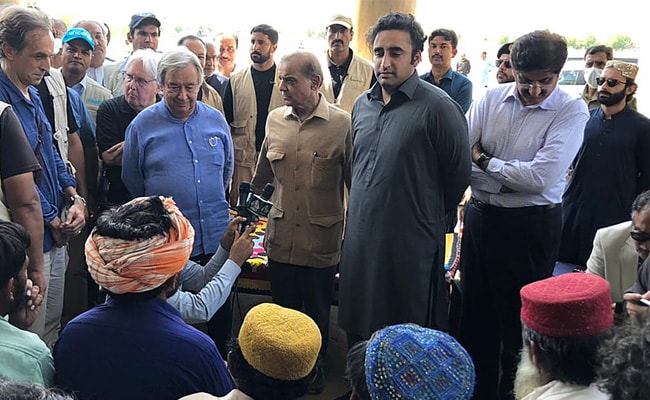UN Secretary General Antonio Guterres said on Saturday that he “had never seen a climate massacre” on a scale like that when he went around the parts of Pakistan that was hit by flooding, blaming rich countries over destruction.
Nearly 1,400 people were killed in floods that covered areas of the size of England and had destroyed plants and destroyed houses, businesses, roads and bridges.
Guterres said he hoped that his visit would galvanize support for Pakistan, which had placed a temporary cost of a disaster of more than $ 30 billion, according to the government flood assistance center.
“I have seen a lot of humanitarian disasters in the world, but I have never seen a climate massacre on this scale,” he said at a press conference in the Port City of Karachi after witnessing the worst damage in South Pakistan.
“I have absolutely no words to describe what I have seen today.”
Pakistan receives heavy rain – often damaging – during the annual rainy season, which is very important for agriculture and water supply.
But the rain as high as this year has not been seen for decades, while the melted glaciers in the north for months have put pressure on the water channel.
“Moral richer countries are morally responsible for helping developing countries such as Pakistan to recover from disasters like this, and adapt to build resilience to climate impacts that unfortunately will be repeated in the future,” Guterres said, adding that the State – The G20 country caused 80 percent of today’s emissions.
Pakistan is responsible for less than one percent of global greenhouse gas emissions but eighth in the list compiled by NGOs Germanwatch from countries that are most vulnerable to extreme weather caused by climate change.
– ‘Insanity and suicide’ –
Around 33 million people have been influenced by floods, which have destroyed around two million houses and business places, removing 7,000 kilometers (4,300 miles) roads and collapsed 500 bridges.
Guterres has regretted the lack of attention given by the world to climate change – especially in industrial countries.
“This is a madness, this suicide is collective,” he said after arriving in Pakistan on Friday.
The effect of heavy rain has two destructive flash floods in the river -Sungai in the north of the mountains, and the slow accumulation of water in the southern plain.
“All children, men and women bake in this hot heat. We have nothing to eat, there is no roof in our heads,” Rozina Solangi, a 30-year-old housewife who lives in the Sukkur displacement camp, told AFP to AFP on Friday.
“He must do something for us poor,” he said of the UN head visit.
The Meteorology Office said Pakistan had received five times more rain than usual in 2022. Padidan, a small town in Sindh Province, has been moistened more than 1.8 meters (71 inches) since the rainy season began in June.
The water level has reached much higher in areas where rivers and lakes have destroyed their banks, creating a dramatic inland sea.
Thousands of temporary campsite have mushroomed on high land in the south and west – often the roads and railroad tracks in the water landscape.
With people and livestock crammed together, the camps are mature for the disease outbreak, with many cases of dengue fever transmitted by mosquitoes reported, and scabies.
During his fast tour, Guterres stopped at several emergency camps and met with desperate flood victims, including a woman who gave birth last night.
Wearing ajrak shawl with a traditional Sindhi block mold, he then examined the 4,500-year-old UNESCO world heritage site, Mohenjo-Daro, who had suffered water damage due to endless monsoon rain.

